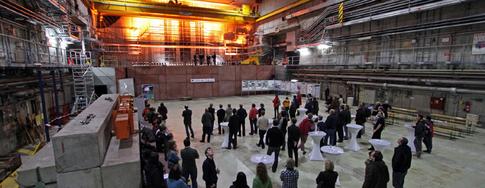XFEL: Research at Hamburg’s deepest scientific workplace resumes
Research at Hamburg’s deepest scientific workplace resumes
At one of Hamburg’s deepest workplaces, research activities have resumed. Three teams of researchers contributing to the new European XFEL X-ray free-electron laser are currently moving into their laboratories in the former experiment building of Hadron-Electron Ring Accelerator (HERA), a particle accelerator at Deutsches Elektronen-Synchrotron (DESY) that was switched off in summer 2007. Other scientists will follow in the coming weeks and months.
The underground building complex HERA South, close to the Bahrenfeld harness racetrack and the Altona Volkspark, stretches over 8 floors and is more than 25 m deep. The more than 1 000 m2 former experiment hall, with a height of 15 m, is at the centre of the complex, which offers 2 000 m2 of test and laboratory area, including more rooms that will now be used as physical laboratories.
About 25 scientists and engineers—many hired for the project in recent months from Germany and numerous other countries—will now start doing research in HERA South, further strengthening research and development in the Hamburg area. Their main tasks will be to develop and test equipment for guiding and controlling the X-ray beam, the scientific instruments for the experiments, the detectors, and the information technology for data acquisition and processing. Currently, these scientists have their offices at the European XFEL headquarters at Albert-Einstein-Ring, which is about 500 metres from HERA South.
The HERA South hall, which stood empty after hosting the 3 600 t ZEUS detector, was given by DESY to European XFEL. Renovation and preparation lasted 12 months, during which more than 300 heavy concrete blocks had to be moved.
“It was well worth the effort”, says Tobias Haas, head of Technical Coordination at European XFEL. “We now have a unique working environment with outstanding infrastructure, steady and controllable conditions, and the possibility to work free of vibrations.”
After completion of the facility, all of the expected 250 employees of European XFEL will move to Schenefeld, the future company headquarters. Researchers will have laboratories above the experiment hall, which will be both the end point and the heart of the more than 3 km long facility. They will install the laser and the corresponding technical equipment, help future users with their experiments, and conduct their own research at the facility. The underground experiment hall is currently under construction. The laboratory and office building, which are being constructed on top of it, are scheduled to be ready in 2015.
About HERA
The Hadron-Electron Ring Accelerator (HERA) was the largest particle accelerator at DESY and Germany’s largest research instrument: a gigantic super electron microscope that provided physicists with the world’s sharpest view of the proton. The accelerator itself is switched off, but the data analysis at the HERA experiments H1, ZEUS, and HERMES is still ongoing. At ZEUS, researchers observed high-energy collisions of electrons and protons in order to unravel the internal structure of the proton and the mysteries of nature’s fundamental forces.

